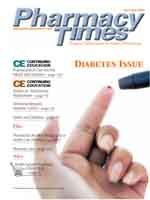New Guidelines Recommend Lower LDL Goal for Diabetes Patients
The integral relationship between diabetes and coronaryheart disease (CHD) has been well established. Statisticsvary, but in general diabetic patients have a 2- to 4-foldgreater risk for myocardial infarction (MI) or stroke thannondiabetics. There are many risk factors that predispose adiabetic patient to develop CHD, including family history,smoking, obesity, low physical activity, hypertension, andhyperlipidemia. The management of lipid abnormalities iscrucial and includes the reduction of low-density lipoprotein(LDL), the reduction of triglycerides, and an elevationin high-density lipoprotein (HDL).
Lowering LDL cholesterol has been shown in many significantclinical trials to reduce macrovascular disease andmortality in patients with type 2 diabetes and remains theprimary aim of lipid-lowering therapy. In July of this year,the National Cholesterol Education Program (NCEP) revisedthe guidelines set forth by the Adult Treatment Panel (ATPIII) in 2001. The ATP produced evidence-based recommendationsfor the management of hyperlipidemia and associateddisorders. Since the release of ATP III, there have been5 large-scale trials using 3-hydroxy-3-methylglutaryl coenzyme A
HMG CoA) reductase inhibitors (more commonly knownas statins) that have established clinical end points.
Diabetes is still classified as a high-risk condition by theATP. The new recommendations address LDL goals for diabetespatients with and without cardiovascular disease(CVD). Diabetic patients with existing CVD are at anextremely high risk for future cardiovascular events, includingmyocardial infarction (MI) or stroke. The previousguidelines for these patients suggested a minimal target LDLgoal of <100 mg/dL. Based on recent evidence, thesepatients benefit the most from additional reduction in LDL,and therefore the new recommendation is to achieve anLDL goal of <70 mg/dL in this patient population.
For diabetics without established CVD, the recommendationssuggest using clinical judgment, based on the presenceof other risk factors, to assess the need for lowering LDLbelow 100 mg/dL. Risk scores can be calculated to determinea patient's 10-year percentage risk of developing CHD. Thisis a useful tool for clinicians in determining whether additionalLDL-lowering therapy is necessary.
The new recommendations by the NCEP do recognize thelimitations of the currently available therapies. Even withhigh-dose statins in combination with other LDL-loweringdrugs, total reductions seen in LDL concentrations are typically<50%. Thus, for patients with a high baseline LDL(>150 mg/dL), it may be difficult to achieve an LDL concentrationof <70 mg/dL.
It is important to note that ATP III, as well as theAmerican Diabetes Association, still supports therapeuticlifestyle changes (TLCs) as first-line therapy for all diabeticpatients, regardless of baseline lipid profiles. In addition,there is now supporting evidence that intensive LDL-loweringtherapy with statin drugs will reduce cardiovascularevents in diabetic patients. Currently, no goals have been setforth from the NCEP regarding the benefits of raising HDLlevels. There has not been enough documentation to date toprove an adequate risk reduction to warrant a change in thecurrent guidelines. New studies are underway, however, sothis will be an exciting area to watch in the future.
Community pharmacists play an integral part in themanagement of hyperlipidemia in diabetes patients.Assessing compliance with lipid-lowering therapies, monitoringfor adverse effects, stressing the importance of adherence,and educating patients on their lipid medications arejust a few of the essential roles played by community pharmacists.
Dr. Brian is a clinical specialist with Cornerstone Healthcare, HighPoint, NC.
For a list of suggested reading, send astamped, self-addressed envelope to:References Department, Attn. A. Stahl,Pharmacy Times, 241 Forsgate Drive,Jamesburg, NJ 08831; or send an e-mailrequest to: astahl@mwc.com.

